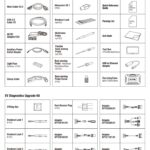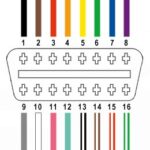The OBD2 code P0455 signals a problem within your vehicle’s Evaporative Emission Control System (EVAP). Specifically, it indicates a “Large Evaporative Emission System Leak Detected.” This doesn’t usually mean a major, performance-affecting issue immediately, but it’s important to address it to prevent environmental harm and potential future problems.
Your car’s EVAP system is designed to prevent fuel vapors from escaping into the atmosphere. It captures these vapors and routes them back to the engine to be burned. When the engine control unit (ECU) detects a large leak in this system, it triggers the P0455 code and illuminates the check engine light on your dashboard.
Several symptoms can accompany a P0455 code, though they are often subtle. The most obvious is the check engine light itself. You might also notice a faint fuel odor around your vehicle, especially after refueling. In some cases, there might be a slight decrease in fuel economy, but generally, P0455 doesn’t cause noticeable driving performance issues.
The causes of a P0455 code are varied, but many are relatively simple to check. The most common culprit is a loose or improperly sealed gas cap. Other potential causes include:
- Faulty or missing gas cap: If your gas cap is old, cracked, or not sealing correctly, it can cause a large leak.
- Damaged fuel filler neck: Corrosion or damage to the filler neck can prevent a proper seal with the gas cap.
- Cracked or disconnected EVAP hoses: The EVAP system uses hoses to route fuel vapors, and these can crack or become disconnected over time.
- Faulty purge valve or vent valve: These valves control the flow of fuel vapors and can fail in the open position, causing a leak.
- Leaks in the charcoal canister or fuel tank: Although less common for a “large leak”, damage to these components can also trigger P0455.
Diagnosing a P0455 code typically starts with a visual inspection. Begin by checking your gas cap – ensure it’s properly tightened and in good condition. Next, inspect the EVAP system hoses for any visible cracks or disconnections. A professional mechanic might use a smoke test to pinpoint the exact location of the leak by introducing smoke into the EVAP system and observing where it escapes. An OBD2 scanner can confirm the P0455 code and may provide additional data.
Fixing a P0455 code can often be straightforward. If the gas cap is the issue, simply tightening or replacing it might resolve the problem. Replacing damaged hoses or faulty valves are also common repairs. More complex issues, such as leaks in the fuel tank or charcoal canister, may require professional diagnosis and repair.
Addressing a P0455 code is important for both environmental reasons and the health of your vehicle. While it may not cause immediate driving problems, neglecting it can lead to further complications and prevent your vehicle from passing emissions tests. By understanding the causes and troubleshooting steps for OBD2 code P0455, you can effectively diagnose and resolve this common EVAP system issue.

